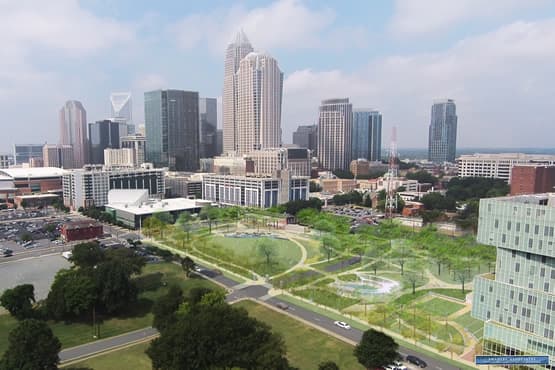First Ward Park to serve as community centerpiece

First Ward Park is being designed as a community centerpiece – it will be bordered by UNC Charlotte Center City and ImaginOn. At a Sept. 18 ceremony to break ground officially for the park, Chancellor Philip L. Dubois said the park always has been part of Daniel Levine and the University’s vision for First Ward.
“Acquisition of land (for UNC Charlotte Center City) was made possible with the generous support of Daniel Levine and his family, and it opened the door for us to approach the General Assembly, which in 2006, appropriated the $50 million required to build what we came to call ‘the stack of books,’” said Dubois. “This iconic 11-story structure will forever serve as one of the important anchor institutions of First Ward.”
 He added, UNC Charlotte is invested in strengthening the First Ward community through higher education, arts and culture, and the University will play a vital role in helping make the park a success.
He added, UNC Charlotte is invested in strengthening the First Ward community through higher education, arts and culture, and the University will play a vital role in helping make the park a success.
A number of dignitaries were on hand to celebrate the impending construction of the First Ward Park; they included elected officials, business and civic leaders and Daniel Levine of Levine Properties.
First Ward Park is a joint partnership between Levine Properties, UNC Charlotte, Mecklenburg County and the city of Charlotte.
With UNC Charlotte Center City as the northern anchor of the park, the University will gain a significant asset through which to offer arts and cultural programming in collaboration with the county. Users of the park will have ready access to the CATS Blue Line extension, with a stop at UNC Charlotte Center City, connecting to the main campus. The Blue Line extension is expected to open for service in 2017.
“First Ward Park will be the University’s front yard, enhancing our connection to our First Ward neighbors and the entire Uptown Community,” said Jerry Coughter, executive director of UNC Charlotte Center City, which opened in summer 2011. The building’s completion marked a historic step forward in a new era of connectivity with the Charlotte community. It provided the University with a versatile space from which to offer academic and community engagement programming tailored to the nearby business and residential community and the rest of Charlotte.